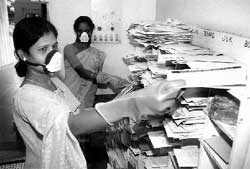Mass destruction knocking at the door
 The threat of terrorists using biological weapons has finally become a reality as anthrax-laced letters continue to inflict American citizens door by door, immediately after the September 11 attacks. Till now six confirmed and 36 suspected cases of anthrax have been reported in the us within a span of 10 days in the current outbreak. As we know, in a biological war, living organisms like bacteria, virus, fungi and rickettsiae and their natural byproducts (toxins) are used to cause large-scale death or disability in human beings, animals and even plants.
The threat of terrorists using biological weapons has finally become a reality as anthrax-laced letters continue to inflict American citizens door by door, immediately after the September 11 attacks. Till now six confirmed and 36 suspected cases of anthrax have been reported in the us within a span of 10 days in the current outbreak. As we know, in a biological war, living organisms like bacteria, virus, fungi and rickettsiae and their natural byproducts (toxins) are used to cause large-scale death or disability in human beings, animals and even plants.
India has long been a victim of terrorism, and has taken this threat seriously though to find that it is awfully equipped to fight such an attack. For a country that has not been able to detect and fight periodic epidemic outbreaks, the threat of terrorists using biological weapons is certainly a challenge. Given past records of fighting such outbreaks, our medical infrastructure needs complete greasing. And it has to be done immediately considering the present situation and its hazards to both human population and to environment.
A sense of panic grips the corridors of the Indian health ministry which is still to identify an unknown virus outbreak in Siliguri, West Bengal that killed 37 people in February 2001. Its autonomous institution National Institute of Communicable Diseases (nicd) is suddenly stealing limelight in its recent campaign in making the political leadership aware of the threat of biological weapons. An organisation that hardly preferred to be in public limelight in the recent past and is still thrifty about sharing information on different disease outbreaks in the country is now ready to flood newspapers with threatening details of biological weapons. Its director has even speculated that the Siliguri outbreak could be a
